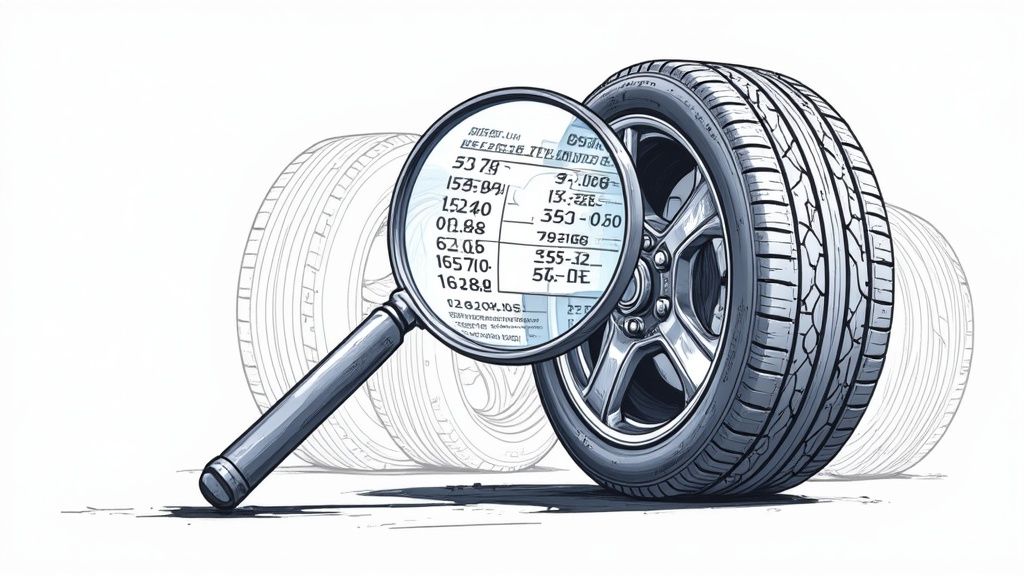
How to Read Tire Codes: Expert Quick Guide
Cracking the Code: Understanding Tire Sidewall Basics
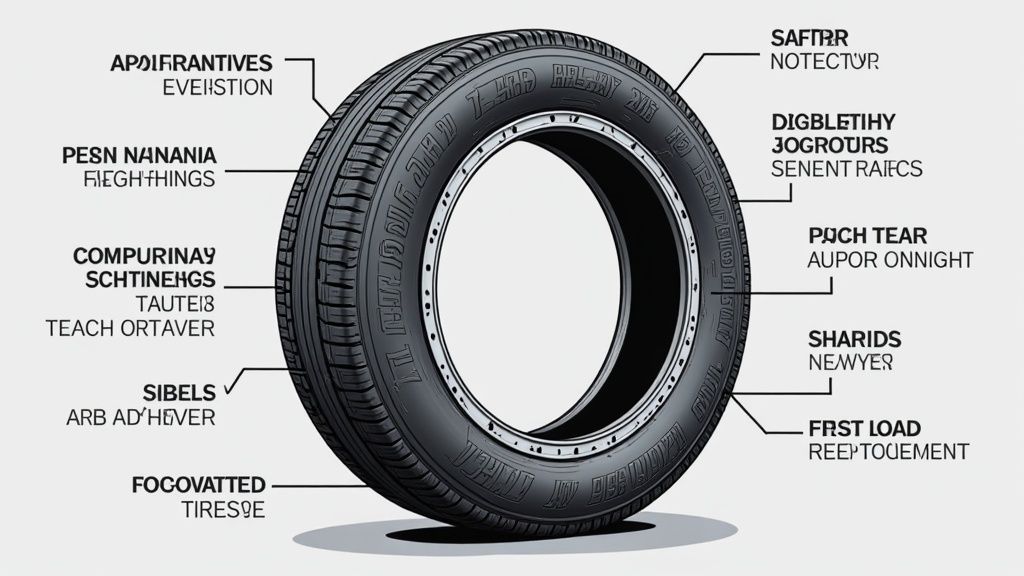
The markings on your tire sidewall aren’t random. They provide essential information about your vehicle’s safety and performance. Knowing how to interpret these codes helps you make smart choices about tire maintenance and replacement. This knowledge contributes to safer driving and can also save you money.
Why Tire Codes Matter
Understanding tire codes ensures your tires are suitable for your vehicle and driving style. For instance, using tires with the wrong load ratings can result in premature wear, blowouts, or even accidents. Knowing the date code helps you avoid driving on old, potentially dangerous tires. This proactive approach is key to vehicle safety.
Proper tire management is essential. In 1971, the Department of Transportation (DOT) mandated a standardized 10-digit Tire Identification Number. This number includes details about the tire’s production date, size, and manufacturer. This standardization ensures easy access to vital information. Want to know more about tire age? Learn more about tire age
Key Elements of the Tire Code
The tire code contains a lot of information. However, certain elements are particularly important for drivers. These include the tire size, load index, speed rating, and date code. Each element plays a specific role in tire performance and safety.
- Tire Size: This indicates the tire’s dimensions, including width, aspect ratio, and rim diameter.
- Load Index: This number shows the maximum weight the tire can safely carry.
- Speed Rating: This letter indicates the tire’s maximum safe sustained speed.
- Date Code: This four-digit number indicates the week and year of manufacture, allowing you to determine the tire’s age.
Practical Benefits of Knowing How to Read Tire Codes
Understanding tire codes empowers you to make informed decisions about your tires. This knowledge is especially helpful in several situations:
- Buying New Tires: Confidently choose the right size, load index, and speed rating.
- Checking for Recalls: Quickly determine if your tires are subject to a recall.
- Maintaining Your Tires: Track tire age and replace them before they become unsafe.
- Inspecting Used Cars: Assess the condition and appropriateness of the tires.
By learning to read these codes, you become a more proactive vehicle owner. You can take steps to ensure safety and optimal performance. In the next section, we’ll explore tire dimensions in detail.
Size Matters: Decoding Tire Dimensions Like a Pro
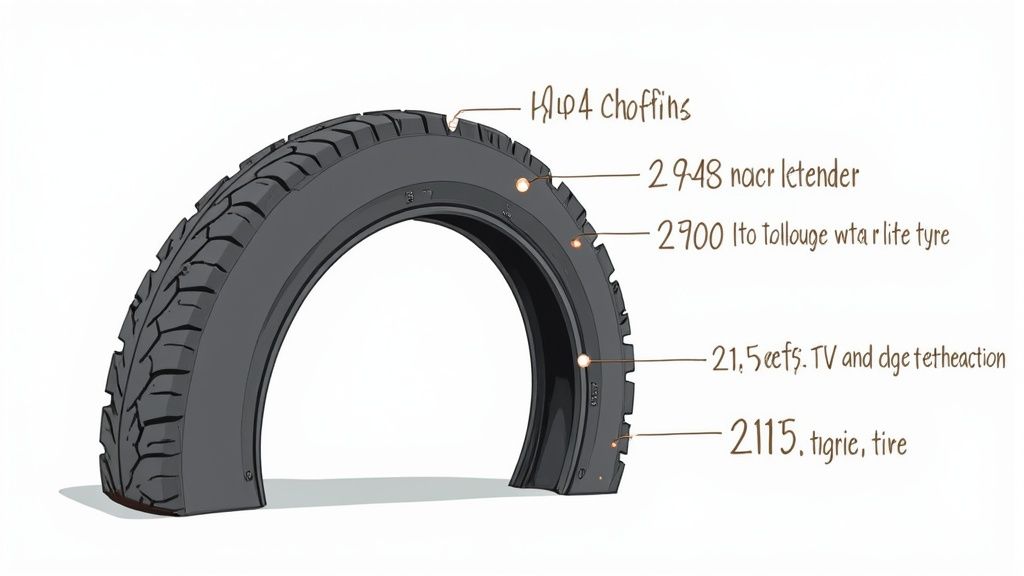
Tire size is the most prominent piece of information on your tire’s sidewall, and it plays a significant role in your vehicle’s performance and handling. These numbers and letters aren’t random; they communicate vital details about your tire’s dimensions and capabilities. Understanding this code is essential for making smart choices about tire replacements and ensuring your vehicle performs at its best.
Deciphering the Tire Size Code
The tire size code may look complex, but each component has a distinct meaning. Let’s analyze a typical example: 225/45R17. To better understand this, we’ll break down each section.
To make this even clearer, let’s look at a table summarizing these components:
To help illustrate this further, here’s a table summarizing the key components of a tire size code:
Tire Size Code Components Breakdown of what each part of the tire size code represents
| Code Element | What It Means | Example Value | Impact on Performance |
|---|---|---|---|
| Section Width | Width of the tire in millimeters | 225 | Wider tires generally offer increased grip and stability, particularly when cornering. |
| Aspect Ratio | Height of the tire’s sidewall as a percentage of the section width | 45 | A lower aspect ratio typically results in sharper handling but a less cushioned ride. |
| Construction | Indicates the tire’s internal construction. “R” denotes radial construction. | R | Radial tires offer better performance and fuel economy than older bias-ply tires. |
| Wheel Diameter | Diameter of the wheel the tire is designed to fit, measured in inches | 17 | This determines wheel and tire compatibility. |
This table provides a concise overview of how each element in the tire code affects performance. Understanding these elements helps ensure you choose the right tires for your vehicle.
More details regarding tire codes can be found on Wikipedia. This resource offers additional information on international standards and variations in tire coding.
How Manufacturers Determine Optimal Tire Size
Vehicle manufacturers carefully select tire sizes considering factors like vehicle weight, intended use, and desired handling. Extensive testing helps them determine the ideal size for each model, balancing performance, comfort, and fuel efficiency.
Consequences of Deviating From Recommendations
Using tires that differ significantly from manufacturer recommendations can lead to various issues:
-
Speedometer Inaccuracies: Larger diameter tires can cause the speedometer to read slower than actual speed, while smaller tires can make it read faster.
-
Transmission Problems: Changing tire size impacts transmission gear ratios, potentially causing premature wear.
-
Handling Issues: Incorrect tire sizes can negatively affect handling and stability, particularly during cornering or sudden maneuvers.
-
Clearance Problems: Oversized tires might rub against wheel wells or other vehicle parts, leading to damage.
Matching Tire Dimensions to Driving Needs
Technicians consider several factors when recommending tire dimensions:
-
Driving Style: Aggressive drivers often prefer wider, lower-profile tires, while those seeking comfort may opt for higher aspect ratios.
-
Climate: All-season tires suit most climates, but winter tires are essential for snowy or icy conditions.
-
Vehicle Type: SUVs and trucks typically require larger, more robust tires compared to passenger cars.
Avoiding Misleading Advice
Be cautious of salespeople upselling unnecessary larger or pricier tires. Consult your owner’s manual or a trusted mechanic for guidance on the correct tire size. Understanding tire codes, especially size specifications, empowers you to make informed decisions about replacements, maximizing vehicle performance and safety. This knowledge enables you to choose the right tires for your vehicle and driving style, enhancing your driving experience.
The Age Factor: Mastering Tire Date Codes
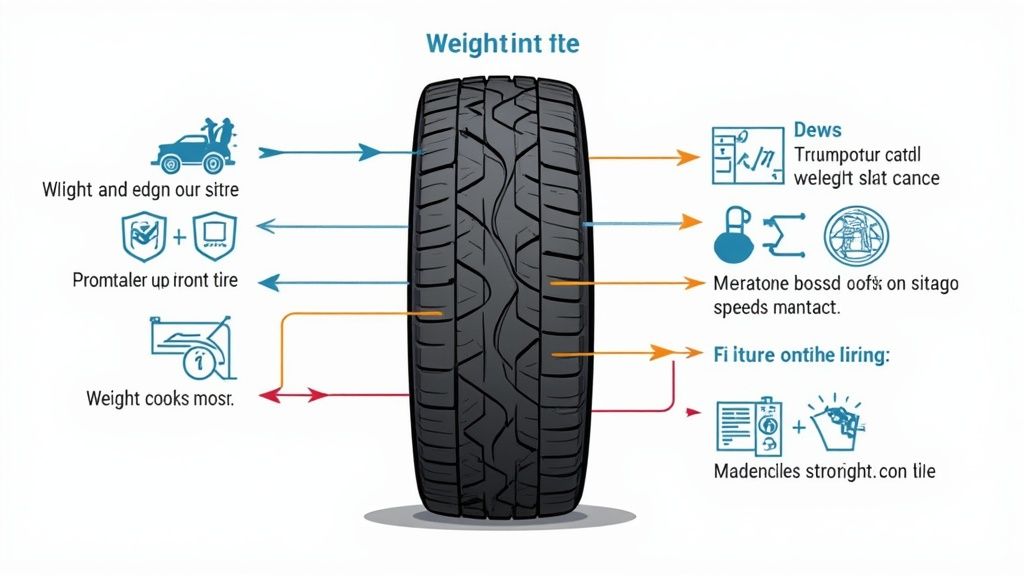
While tread depth offers a valuable visual cue for tire wear, it doesn’t provide a complete picture of tire health. Tires with ample tread can still pose safety risks due to age-related degradation. The rubber compounds within tires deteriorate over time, impacting their elasticity and making them susceptible to cracking and failure. Understanding tire date codes is essential for maintaining vehicle safety.
Locating and Interpreting the Date Code
The tire date code is a four-digit number imprinted on the tire sidewall, typically within the DOT markings. This code reveals the week and year of the tire’s manufacture. For instance, the code “1023” signifies production in the 10th week of 2023. This seemingly minor detail plays a significant role in tire safety and performance.
Pre-2000 vs. Modern Date Codes
Tires manufactured before 2000 use a three-digit date code. The first two digits indicate the week of manufacture, and the last digit represents the year within the decade. A code like “306” could refer to 1976, 1986, or 1996. This ambiguity can make pinpointing the exact manufacturing year challenging.
For tires made before 2000, accurately determining the year of manufacture can be difficult. The three-digit code, while providing the week, only offers the last digit of the year. This means a code like “306” could represent 1976, 1986, or 1996. Despite this challenge, knowing the approximate age is still crucial. Coker Tire offers further insights into tire aging. The modern four-digit system, adopted in 2000, removes this ambiguity, simplifying the process of determining a tire’s age.
Why Tire Age Matters, Even With Good Tread
Several factors contribute to tire degradation, including oxidation, UV exposure, and temperature fluctuations. Importantly, even unused tires are subject to this deterioration. Consequently, a tire with sufficient tread depth might still be unsafe if the rubber is aged and compromised. Over time, the tire’s structural integrity weakens, increasing the risk of blowouts or other hazardous failures.
Tracking Tire Age and Replacement Strategies
Understanding tire date codes empowers proactive tire management. Maintaining records of these codes for all your tires is essential. Tools like Auto Service Logger can help store and access this vital information, ensuring you never lose track of your tires’ age, which is crucial for both safety and performance.
The Importance of Timely Tire Replacement
Industry experts recommend replacing tires every 6 to 10 years, irrespective of remaining tread depth. This guideline acknowledges the inevitable degradation of rubber compounds over time. Neglecting tire age can contribute to preventable accidents. Regularly checking and recording your tire date codes is a key preventative measure.
Practical Tips for Maintaining Tire Records
Several methods can be used to track tire date codes, including spreadsheets, notebooks, or dedicated platforms like [Auto Service Logger](MISSING LINK). This ensures easy access to this important information. Regularly checking these codes during routine maintenance or tire rotations is a recommended practice. This proactive approach helps you stay informed about your tires’ condition. By integrating tire age into your maintenance routine, you significantly contribute to road safety and optimal vehicle performance. This knowledge enables informed decisions about tire replacement, prioritizing your safety and the safety of your passengers.
Safety By The Numbers: Load and Speed Ratings Decoded
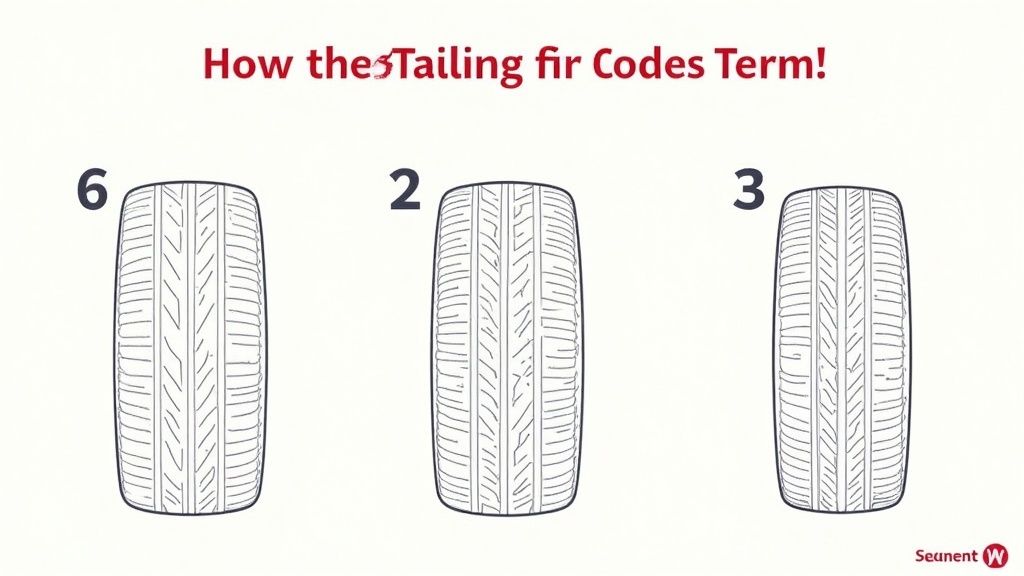
Understanding tire dimensions and age is essential. But equally important are the load index and speed rating. These codes, part of the tire sidewall markings, reveal crucial information about a tire’s performance capabilities. Knowing how to interpret these codes helps you select the right tires for your vehicle and driving style, ensuring optimal safety and handling.
Understanding Load Index
The load index is a numerical code that indicates the maximum weight a single tire can safely carry. This number isn’t the weight itself; it corresponds to a specific weight in pounds found in a load index chart. For instance, a load index of 95 might represent 1521 lbs. Choosing tires with a load index that meets or exceeds your vehicle’s gross vehicle weight rating (GVWR)—the maximum operating weight as specified by the manufacturer—is critical.
Decoding The Speed Rating
The speed rating, represented by a letter, specifies the maximum speed a tire can safely sustain under specific conditions. Speed ratings typically range from L (75 mph) to Y (186+ mph). Regularly exceeding a tire’s designated speed rating, particularly over extended durations, can generate excessive heat. This heat buildup compromises the tire’s structural integrity, increasing the risk of a blowout or other tire failure.
Matching Ratings to Your Vehicle
Selecting the appropriate load and speed ratings depends on your individual driving habits and the type of vehicle you own. High-performance vehicles typically require high speed ratings for optimal performance and safety at higher speeds. Most passenger cars, however, can function safely with lower speed ratings. Even if you primarily drive at lower speeds, opting for a higher speed rating can provide an added safety margin, especially in emergency maneuvers or when carrying heavier loads.
Why Exceeding Limits Is Dangerous
Pushing a tire beyond its designated load index or speed rating jeopardizes its structural integrity and overall performance. Overloading can cause premature wear and tear, sidewall bulges, and even sudden tire failure. Exceeding the speed rating generates excessive heat, weakening the tire’s internal structure and making it susceptible to blowouts. These situations can result in a loss of vehicle control, potentially leading to serious accidents.
The table below offers a glimpse into various speed ratings and their corresponding maximum speeds. Consult a comprehensive tire speed and load index chart for a complete listing.
Tire Speed and Load Ratings Comparison Complete reference guide to tire speed and load ratings
| Rating Symbol | Maximum Speed | Load Capacity (lbs) | Typical Vehicle Applications |
|---|---|---|---|
| L | 75 mph | Varies | Spare tires, some light trucks |
| M | 81 mph | Varies | Temporary spares, some trailers |
| N | 87 mph | Varies | Light trucks, minivans |
| P | 93 mph | Varies | Passenger cars, minivans |
| Q | 99 mph | Varies | Light trucks, SUVs |
| R | 106 mph | Varies | Passenger cars, minivans, SUVs |
| S | 112 mph | Varies | Passenger cars, sports sedans |
| T | 118 mph | Varies | Passenger cars, minivans, SUVs |
| U | 124 mph | Varies | High-performance cars, sports cars |
| H | 130 mph | Varies | Sports sedans, coupes |
| V | 149 mph | Varies | High-performance cars, sports cars |
| W | 168 mph | Varies | Exotic sports cars, supercars |
| Y | 186+ mph | Varies | High-performance sports cars, supercars |
This table shows how speed ratings correlate with maximum speed capabilities. Remember to check the load index as well to ensure your tires are appropriately rated for your vehicle’s weight.
Practical Application: Making Informed Choices
Suppose you’re shopping for new tires for your truck and come across a set with the code “265/70R17 115S”. You’ve deciphered the size, but what about the “115S”? The 115 is the load index, representing the tire’s load-carrying capacity. The S is the speed rating, indicating its maximum safe speed. Using a chart, you can determine the precise weight and speed limits associated with these codes, ensuring they align with your truck’s requirements and your driving habits. Tools like Auto Service Logger can help you maintain a record of these specifications for all your vehicles, simplifying future tire purchases and ensuring you consistently make informed choices. You can store your current tire codes and refer to them quickly when selecting replacements.
Beyond The Basics: Advanced Tire Markings Explained
Beyond size, age, load index, and speed rating, your tire’s sidewall contains a wealth of information about its performance capabilities. These advanced markings differentiate an all-season tire from a winter tire, or a highway tire from an all-terrain tire. Understanding these markings helps you select the right tire for your driving needs and conditions.
Understanding UTQG Ratings
The Uniform Tire Quality Grading (UTQG) system provides a standardized method for comparing tires across brands. This system grades tires on treadwear, traction, and temperature resistance. The treadwear grade is a relative measure of a tire’s tread life. A higher number indicates a longer-lasting tread.
Traction grades, ranging from AA to C, reflect a tire’s ability to stop on wet pavement. Temperature grades, from A to C, indicate a tire’s resistance to heat buildup.
Treadwear, Traction, and Temperature: A Deeper Dive
UTQG ratings offer a valuable starting point for tire comparison. For example, a tire with a 600 treadwear grade should theoretically last twice as long as a tire with a 300 grade. However, these ratings are based on controlled testing, and real-world performance varies depending on driving habits, road conditions, and vehicle type.
Traction and temperature grades are equally important, especially for safety in adverse weather. Higher grades in these categories generally indicate better performance in wet or hot conditions.
Construction Indicators and Their Impact on Performance
Tire construction indicators reveal the materials and design used within the tire. These indicators, often abbreviations or symbols, can signify features like reinforced sidewalls, special tread compounds, or run-flat capabilities.
These features translate to tangible differences in driving experiences. A tire with reinforced sidewalls may offer enhanced durability and puncture resistance. A run-flat tire allows for continued driving after a puncture, a crucial safety feature in emergencies.
The Aspect Ratio’s Role in Handling and Comfort
The tire’s aspect ratio significantly influences handling and ride comfort. The aspect ratio, the sidewall height as a percentage of the section width, impacts how the tire performs. Common aspect ratios include 70%, 75%, and 80%. Lower ratios generally offer better handling but a potentially harsher ride. Explore this topic further.
A lower aspect ratio can provide more responsive handling and improved cornering grip, but may transmit more road imperfections to the cabin. Conversely, a higher aspect ratio absorbs bumps more effectively, leading to a smoother, but potentially less precise, ride. Understanding these trade-offs helps you choose a tire that balances performance and comfort.
Matching Specialty Designations to Your Needs
Matching specialty designations to your climate, driving style, and vehicle ensures optimal tire performance. Drivers in snowy regions might opt for winter tires with the “M+S” (mud and snow) designation. Off-road enthusiasts might choose tires with the “A/T” (all-terrain) designation.
These specialized markings offer performance advantages in specific driving conditions, highlighting the importance of understanding tire codes. You can track preferred tire specifications for each vehicle using Auto Service Logger. This ensures you have the information when it’s time for replacements. Check out Auto Service Logger.
Confusing Similar Tire Sizes
Misreading tire size specifications is a surprisingly common mistake, even among experienced drivers. A seemingly small difference, like mistaking a 215/55R17 tire for a 225/55R17, can significantly impact your vehicle’s performance. That 10mm variation in section width affects handling and speedometer accuracy. Using the incorrect wheel diameter can lead to improper fitment and potential damage, even wheel separation.
Misunderstanding Load and Speed Ratings
Tire codes also include crucial information about load index and speed rating. Overlooking these ratings can have serious consequences. A tire with a lower load index than required risks overloading, increasing the chances of tire failure, especially when carrying heavy loads or passengers. Exceeding the speed rating generates excessive heat, which weakens the tire and makes blowouts more likely at high speeds.
Neglecting the Tire’s Age
Many drivers focus on tread depth and forget about the tire date code. This code tells you the week and year the tire was manufactured. Over time, rubber compounds deteriorate, even if the tread looks good. Older tires are more susceptible to cracking and blowouts, and their performance degrades, especially in challenging weather. Experts advise replacing tires every six to ten years, regardless of remaining tread.
Incorrect Tire Type Selection
Choosing the wrong type of tire for your driving conditions is another frequent error. Using all-season tires in harsh winter weather significantly compromises traction and handling, making accidents more likely. Conversely, using high-performance summer tires in cold temperatures reduces grip and braking performance.
Verifying Tire Information
-
Check Your Owner’s Manual: Your owner’s manual specifies the recommended tire size, load index, and speed rating for your vehicle.
-
Consult a Tire Professional: If you have any doubts about tire codes, a tire professional can provide expert guidance.
-
Use Online Resources: Tire manufacturer websites and automotive forums offer valuable information on deciphering tire codes. You can also use Auto Service Logger to store and easily access your vehicle’s tire information.
-
Regular Tire Inspections: Regularly inspect your tires for wear and tear, looking for cuts, bulges, and uneven tread wear.
By understanding these common mistakes and taking steps to verify your tire information, you can ensure optimal vehicle safety and performance. Choosing the correct tires not only enhances your driving experience but also saves you money in the long run.
Practical Applications: Putting Your Tire Code Knowledge To Work
Now that you understand how to read tire codes, let’s explore how this knowledge translates into real-world advantages. Decoding these codes isn’t just about deciphering a sequence of numbers and letters; it’s about making informed decisions that impact your budget and, most importantly, your safety.
Confident Tire Shopping
Imagine you’re shopping for new tires. Understanding tire codes empowers you to choose the right size, load index, and speed rating for your vehicle. This knowledge helps you avoid costly errors and ensures optimal vehicle performance. You can confidently ask salespeople targeted questions, compare various tire models, and avoid unnecessary upsells.
Inspecting Potential Vehicle Purchases
When considering a used car, inspecting the tires is essential. Checking the date code reveals the tires’ age, a frequently overlooked factor. Even if the tread appears sufficient, old tires can pose a safety risk. This information allows you to negotiate a fair price or account for the expense of new tires. A quick glance at the sidewall markings can also highlight potential problems and provide valuable insights into the previous owner’s maintenance practices.
Communicating With Service Professionals
Knowing how to read tire codes facilitates effective communication with mechanics and tire technicians. You can ask insightful questions, understand their recommendations, and identify any potential discrepancies. This knowledge builds trust and helps ensure you receive the best possible service. This is particularly valuable when diagnosing handling problems or addressing unusual tire wear. You can confirm that the suggested replacement tires match your vehicle’s specifications and your individual driving needs.
Documenting and Tracking Tire Performance
Create a system for recording your vehicle’s tire specifications and maintenance history. This documentation becomes invaluable when buying replacements or comparing tire performance across different brands or models. This detailed record can reveal wear patterns, pinpoint potential alignment issues, and help you discover which tire brands provide the best value for your driving style and conditions. A simple spreadsheet or a dedicated platform like Auto Service Logger can streamline this process.
Creating a Personalized Maintenance Schedule
By tracking tire age, you can establish a personalized maintenance schedule. This ensures timely tire replacements and helps prevent driving on potentially hazardous, aged-out tires. This proactive strategy improves safety and saves you money in the long run by avoiding premature tire failures and potential vehicle damage. Regularly checking your tire date codes, including those on spare tires, is a vital part of proactive maintenance.
Ready to simplify vehicle maintenance and track important tire information effortlessly? Auto Service Logger provides a complete solution for logging and storing all your vehicle maintenance records, including tire specifications, service history, and more. Secure your lifetime membership today and enjoy the peace of mind that comes with having all your crucial vehicle data readily accessible.